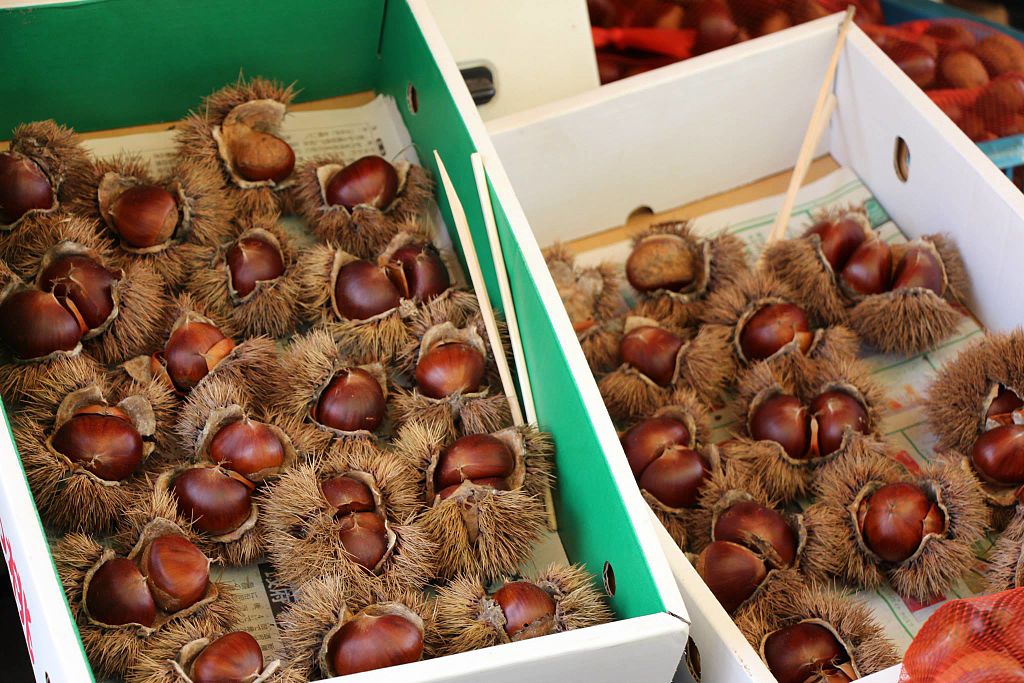Oct 24, 2016
It’s Fall in Japan; Time to get Nutty about Chestnuts

For many folks autumn in Japan means chestnuts. Asia is known as both the largest producer and the largest consumer of chestnuts in the world. Scientists studying the remains of ancient hillside villages in Japan have documented the use of nuts as food sources as far back as 9,000 years. One of the attractions of chestnuts is that they can be consumed with little preparation, once the prickly husks are dealt with. The husks can be burned to roast the nuts inside or, more commonly, chestnuts are boiled or roasted over a fire.
Many chestnut trees can still be found in the wild but many more have been cultivated in Japan over thousands of years. In Osaka Prefecture the go-to chestnut is the Ginyose variety, also known as tanba chestnuts. The trees are native to the Nose area in the northwest section of the prefecture. There are several farms in the area where families go to gather the delicious nuts off the ground. At Mizukoshi Chestnut Farm, the Ginyose chestnuts begin ripening in mid-September and continue through the season. For a small price (typically 1,500 yen), amateur harvesters can gather up about one kilogram of chestnuts to bring home.
Mizukoshi Chestnut Farm
104 Katayama Nose-chō, Toyono-gun, Ōsaka-fu 563-0354 (map link)
TEL : 072-734-0863
Mizukoshi Chestnut Farm (JP)
More Farms, More Chestnuts
Other farms offer different varieties of chestnuts which ripen at different times during the fall months. The orchards at Shionoyu Hot Spring feature the fruit of the Waseguri that are ready in September and the late-ripening Shimokatsugi that drop nuts in late October. Shionoyu also grows Ginyose trees on its terraced slopes. And of course, a soothing hot spring bath after a day of harvesting is a special treat.
The restaurant Nishikitei also owns five hills of chestnut orchards which is open for public gathering. The Kurisuen Chestnut Farm Nishikitei specializes in Ginyose chestnuts and visitors can indulge in chestnut-augmented dishes with sticky rice in addition to carting home bags of chestnuts. If you have never considered gathering chestnuts before, in Japan it is not an autumn indulgence that can be undertaken on a whim – most of the area’s chestnut farms require reservations before you pick so phone ahead for full information.
Kurisuen Chestnut Farm Nishikitei
55 Kurusu, Nose-chō, Toyono-gun, Ōsaka-fu 563-0351 (map link)
TEL : 072-734-0028
Kurisuen Chestnut Farm Nishikitei (JP)
One Last Chance to Party in the Streets
And if you are out gathering chestnuts it means that Shinno-sai is not far away. Shinno-sai is the last festival of the year in Osaka and others know the celebration by its nearly literal name – Tome-no-matsuri, or “The Stop Festival.” The party takes place in Osaka’s “medicine quarter” on the grounds of Sukunahikona Shrine. These were the stomping grounds of the Shinto deity of medicine Doshomachi and was the place in the early 1700s were dozens of brokers of medicinal potions were permitted to operate. Today the Doshomachi Pharmaceutical and Historical Museum explains these traditional herbs, roots and barks that once dominated life in Japan.
These days those practitioners of so-called modern medicine still come to the shrine in Medicine-town to offer up prayers for health and prosperity. The street festival is held in relatively tight quarters but there are typical large helpings of Japanese food and culture. The dates for the last big blow-out in the city are November 22-23 and the festival is free to all.
Sukunahikona Shrine
Japan, 〒541-0045 Osaka Prefecture, Osaka, Chuo Ku, Doshōmachi, 2 Chome 1−8 (map link)
sinnosan.jp
+81 6-6231-6958
By Ant3202 (Own work) [CC BY-SA 4.0], via Wikimedia Commons


About the author